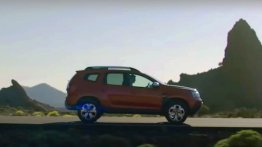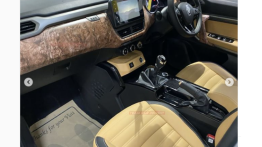Over a year and 70,000 deliveries later, Renault India has finally brought the much anticipated 1.0L version of the Renault Kwid in India. We can't help but wonder what recent buyers of the current Kwid 0.8L would be feeling right now, knowing that a more powerful version is about to launch in the market (the Kwid 1L launches today).

As its closest rivals like the Maruti Alto and Hyundai Eon are available with bigger 1.0L engine options, it was no surprise that Renault would jump that bandwagon for their best-selling 'baby SUV'.
On paper, the 14 PS and 19 Nm bump over the 800 cc engine's output should add some punch to the Kwid 1L's drivability. To experience it, IAB was invited for the first media drive of the Renault Kwid 1.0 in Chennai.

In my reviews, I usually delve into the exterior and interior of the car, before talking about the engine and other aspects. However, the biggest highlight of the Kwid 1.0 is its engine, and there are people eager to know if the increased displacement has made a difference. And besides, you can tell from the image above that it doesn't look all that different from the Kwid 0.8.
The Kwid 1.0 is powered by a 999 cc (1.0L) three cylinder engine, which produces 68 PS at 5,500 rpm and 91 Nm at 4,250 rpm. It is an up-sized version of the 0.8L (799 cc) three cylinder engine, which in itself is an all new engine from Renault. Like the 0.8L, the Kwid 1.0L is paired to a 5-speed manual gearbox as standard, while an Easy-R AMT option exclusive the 1.0L variant will launch shortly.

At startup and crawling speeds, the characteristics of the 1.0L engine feel a bit more refined than its less powerful twin, but by a small margin. The typical three cylinder vibrations and 'whine' do permeate into the cabin, yet it's not as bothersome as other three-cylinder powered cars we've experienced. In traffic-congested streets of Chennai, where speeds are usually under 50 km/h, the Kwid 1.0 drives just as good as the Kwid 0.8.
A bulk of the increased torque is spread between the mid and high rpm range, and it's here where the Kwid 1.0 feels peppier. Also, with a full load of passengers inside, the Kwid 1.0 doesn't struggle as much as the Kwid 0.8 under hard acceleration.

Where the Kwid 0.8's power band tapers off at around 100 km/h on a highway, the Kwid 1.0 would comfortably cruise at 120 km/h. Mediocre highway drivability and unnerving overtakes at high speeds were a couple of the more dislikes of the Kwid 0.8, which has been sorted out in the Kwid 1.0.
The increased power of the 1.0L engine can be felt when you sprint from 70 km/h to 120 km/h in 4th gear. In fact, it is capable of accelerating unto a max top speed of 155 km/h (in-built speedometer), although the car's stability does make one feel uncomfortable at such speeds.

Despite the upsize, fuel efficiency hasn't taken a big hit. According to ARAI, the Kwid 1.0 is capable of averaging a fuel efficiency of 23.01 km/L, which is not that far off from the Kwid 0.8's 25.17 km/L figure. Given that our time was limited, we couldn't perform any fuel efficiency tests in the Kwid 1.0.
The 5-speed manual gearbox and clutch combo is similar to the Kwid 0.8. Shifting through gears was smooth and sure-slotting, while the clutch pedal weight is light and easy to get acquainted with.

The ride quality and handling characteristics of the Kwid 1.0 are largely similar to the Kwid 0.8. The softer suspension setup gobbles up potholes and speed bumps with relative ease at low speeds, complementing the rugged appeal of the Kwid. However, it doesn't feel planted to the road at triple digit speeds, despite being 40 kg heavier and capable of reaching said speeds.
In cities, owners will appreciate the light electric-assist steering system for quick maneuvers and effortless parking into tough spots. Out on the highway, the steering continues to remain light, which dulls much-needed confidence required for an A-segment hatchback at high speeds.

The exterior of the Renault Kwid 1.0 barely looks any different to the Kwid 0.8. Features like gloss grey ORVM caps and black/white chequered graphics on the lower portion of both sides help differentiate the Kwid 1.0 from its less powerful twin, although customers would expect more differentiating features for the extra they're paying over the Kwid 0.8. Of course, Renault does offer plenty of accessory options for the Kwid at an extra cost, should you wish to further personalize your ride.

While we're okay with the interior styling and trim being identical to the Kwid 0.8, it's surprising that Renault India skimped on features like a passenger airbag, ABS, internal adjustments for the ORVMs and even a digital tachometer for the Kwid 1.0. Regardless, the Kwid 1.0 is still the most feature-packed hatchback in its segment.

Only available in the top-end RxT and RxT (O) grade, it comes equipped with a 7 inch MEDIANAV touchscreen system, bluetooth connectivity and navigation, a multi-info display under the digital speedometer, optional driver's airbag and front 'Pro-Sense' seat-belt pre-tensioners, and central locking.
First Impressions
While most manufacturers are downsizing their engine options these days, Renault has taken the opposite route for the Kwid, which is expected when the only engine option available was a 799 cc engine. Prospective customers complaining about the lack of power in the Kwid 0.8 now have a solution.

The Kwid 1.0 feels peppier off the line and more relaxed on highways than the Kwid 0.8, whilst maintaining a small difference in fuel efficiency. Pair that to its existing USPs, and the Renault Kwid becomes a much more appealing option in the budget hatchback segment than it already is.












